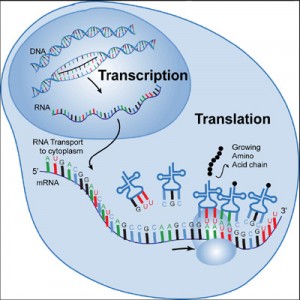04 Jan Transcription: A Word With Many Meanings
For our first post of 2012, we bring you a short lesson in the language of transcription:
In the English language we have the wonderful tradition of using the words that carry multiple meanings depending on the context. The word “transcription” or “transcribe” is no stranger to the homonym phenomenon. Context is the key and depending on what industry, field, or time period your in, “transcription services” could mean several different things.
Transcription: In biological context
In layman’s lingo, genetics uses the term transcription to describe the process by which cells replicate themselves using DNA and RNA to express different genes.

Genetic transcription is defined as follows by Wikipedia:
“ Transcription is the process of creating a complementary RNA copy of a sequence of DNA.[1] Both RNA and DNA are nucleic acids, which use base pairs of nucleotides as a complementary language that can be converted back and forth from DNA to RNA by the action of the correct enzymes. During transcription, a DNA sequence is read by RNA polymerase, which produces a complementary, antiparallel RNA strand. As opposed to DNA replication, transcription results in an RNA complement that includes uracil (U) in all instances where thymine (T) would have occurred in a DNA complement…
… Transcription is the first step leading to gene expression. The stretch of DNA transcribed into an RNA molecule is called a transcription unit and encodes at least one gene. If the gene transcribed encodes a protein, the result of transcription is messenger RNA (mRNA), which will then be used to create that protein via the process of translation. Alternatively, the transcribed gene may encode for either ribosomal RNA (rRNA) or transfer RNA (tRNA), other components of the protein-assembly process, or other ribozymes… ”
Transcription: In Historical Context
During the early European Renaissance, prior to the invention of the printing press, the “scriptorium” was a place where monks would transcribe copies of texts, (generally religious in nature). Transcribing in this context refers to the process of copying a book word for word and verifying the accuracy of the duplicated work. The “scribes” or transcriptionists would have an individual workspace where they would carefully duplicate the most important texts of the time. To put this in proper context, without transcription, the Renascence would have never been able to take hold and the great ancient works of The Old and The New Testament may have been lost to history.

Transcription: In the Modern World
The transcription that you are probably concerned with, and we are in the service of providing, has nothing to do with the age of enlightenment, nor the division of cells. Transcription today is all about converting spoken words into digital or physical form. Transcription in the 21st century can be broken down into three main categories:
- Transcription of audio / video for production
- Legal Transcription
- Medical transcription
Each one of these three types of modern transcription has a completely different professional use and method. For example, Medical Transcription is used for long portions of recorded audio, highly technical in nature, coming from a single speaker, and usually transcribed using speech to text technology such as dragon.
Word Wizards specializes in transcription of audio and video for production purposes. To transcribe media of this nature, it is impossible to effectively use speech to text technology, and the use of “time code” is particularly helpful. We often get asked about the various meanings and forms of transcription, so we hope that this article can help clarify the differences between different uses of the word.

Hope all is made clear now, if you would like more information about transcription or our other professional services, please don’t hesitate to contact your friends here at Word Wizards!



